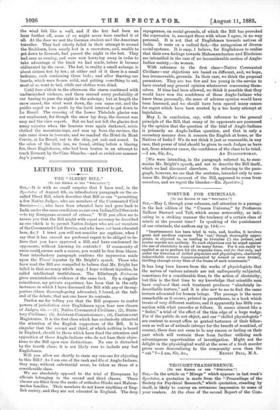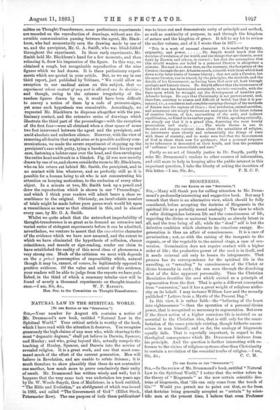THOUGHT-TRANSFERENCE.
[To THE EDITOR OP THII " SPEcrATolt."]
Sin, —In the article on " Mirage " which appears in last week's Spectator, a quotation is made from the " Proceedings of the Society for Psychical Research," which quotation, standing by itself, is likely to convey an erroneous impression to some of your readers. At the close of the second Report of the Com-
raltbee on Thought-Transference, some preliminary experiments are recorded on the reproduction of drawings, without any dis- cernible communication passing between the agent, Mr. Black- burn, who had momentarily seen the drawing made by one of ns, and the percipient, Mr. G. A. Smiti, who was blind-folded throughout the experiment. In these early experiments, Mr. Smith held Mr. Blackburn's hand for a few moments, and then releasing it, drew his impression of the figure. In this way, we obtained a rough, but recognisable reproduction of the nine figures which we had drawn. It is these preliminary experi- ments which are quoted in your article. But, as we say in our third report, just published by Triibner, " We could allow no exception to our cardinal axiom on this subject, that no experiment where contact of any sort is allowed can be decisive ; and though, owing to the extreme irregularity of the random figures drawn by us, it would have been difficult to convey a notion of them by a code of pressure-signs, yet some such hypothesis was conceivable. Accordingly, we requested Mr. Blackburn to dispense altogether with the pre- liminary contact, and the extensive series of drawings which illustrate the third part of the proceedings—with the exception of the first four—were all obtained when a clear space of some two feet intervened between the agent and the percipient, and amid absolute and unbroken silence. However, with the view of removing all doubts that might arise as to possible auditory com- munications, we made the severe experiment of stopping np the percipient's ears with putty, tying a bandage round his eyes and ears, fastening a bolster-case over the head, and then enveloping the entire head and trunk in a blanket. Fig. 22 was now secretly -drawn by one of us, and shown outside the room to Mr. Blackburn, who on his return sat behind -Mr. Smith, the percipient, and in no contact with him whatever, and as perfectly still as it is possible for a human being to sit who is not concentrating his attention on keeping motionless, to the exclusion of every other object. In a minute or two, Mr. Smith took up a pencil and -drew the reproduction which is shown in our " Proceedings,' and which I think your readers will admit bears a close re- semblance to the original. Obviously, an incalculable number of trials might be made before pure guess-work would hit upon a resemblance as near as that obtained in this, and in almost every case, by Mr. G. A. Smith.
Whilst we quite admit that the antecedent improbability of thought-transference is so great as to demand an extensive and varied series of stringent experiments before it can be admitted, nevertheless, we venture to assert that the cumulative character Of the evidence which we have now amassed, and the extent to which we have eliminated the hypothesis of collusion, chance .coincidence, and muscle or sign-reading, render our claim to have established the reality of this novel class of phenomena a very strong one. Much of the criticism we meet with depends on the a priori presumption of impossibility which, natural though it may be, cannot, of course, be legitimately opposed to positive evidence. Of the value and extent of this evidence, your readers will be able to judge from the reports we have pub- lished, in the third of which a summary tabular view will be found of .nearly a thousand experiments on thought-transfer- Hon. Sec. to the Committee on Thought-Transference.



































 Previous page
Previous page